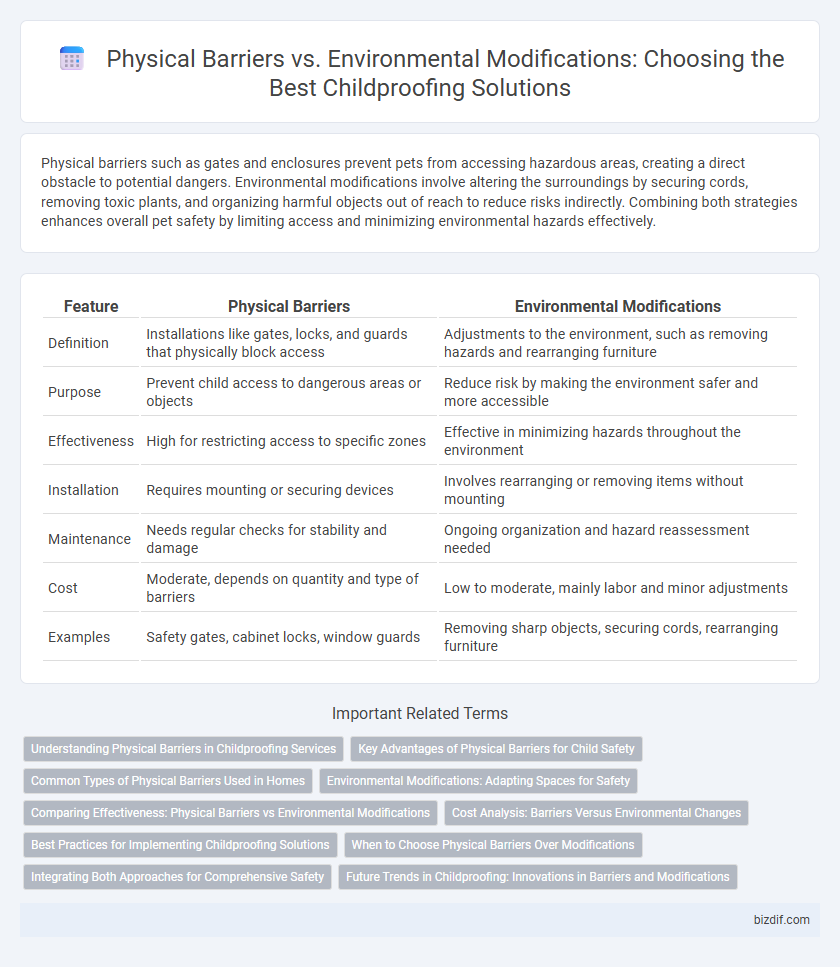Physical barriers such as gates and enclosures prevent pets from accessing hazardous areas, creating a direct obstacle to potential dangers. Environmental modifications involve altering the surroundings by securing cords, removing toxic plants, and organizing harmful objects out of reach to reduce risks indirectly. Combining both strategies enhances overall pet safety by limiting access and minimizing environmental hazards effectively.
Table of Comparison
| Feature | Physical Barriers | Environmental Modifications |
|---|---|---|
| Definition | Installations like gates, locks, and guards that physically block access | Adjustments to the environment, such as removing hazards and rearranging furniture |
| Purpose | Prevent child access to dangerous areas or objects | Reduce risk by making the environment safer and more accessible |
| Effectiveness | High for restricting access to specific zones | Effective in minimizing hazards throughout the environment |
| Installation | Requires mounting or securing devices | Involves rearranging or removing items without mounting |
| Maintenance | Needs regular checks for stability and damage | Ongoing organization and hazard reassessment needed |
| Cost | Moderate, depends on quantity and type of barriers | Low to moderate, mainly labor and minor adjustments |
| Examples | Safety gates, cabinet locks, window guards | Removing sharp objects, securing cords, rearranging furniture |
Understanding Physical Barriers in Childproofing Services
Physical barriers in childproofing services include gates, cabinet locks, and outlet covers designed to restrict a child's access to potentially hazardous areas. These barriers create a controlled environment by blocking entry to stairs, sharp objects, or electrical outlets, reducing injury risk. Effective implementation of physical barriers works alongside environmental modifications to enhance overall home safety for children.
Key Advantages of Physical Barriers for Child Safety
Physical barriers provide a tangible and immediate layer of protection by restricting access to hazardous areas, significantly reducing the risk of accidents and injuries in homes. These barriers, such as safety gates, cabinet locks, and corner guards, are effective in creating safe zones that prevent children from encountering dangers like sharp objects, chemicals, or stairways. Their durability and ease of installation make physical barriers a practical solution for parents seeking reliable childproofing methods.
Common Types of Physical Barriers Used in Homes
Common types of physical barriers used in homes for childproofing include safety gates, outlet covers, cabinet locks, and corner guards. These barriers prevent access to hazardous areas such as stairways, electrical outlets, and cabinets containing toxic substances. Effective installation of these physical barriers significantly reduces the risk of childhood injuries by restricting children's movement within unsafe zones.
Environmental Modifications: Adapting Spaces for Safety
Environmental modifications enhance child safety by adapting living spaces to reduce hazards and prevent accidents. Installing non-slip flooring, securing cords, and adjusting furniture layout create safer environments that minimize injury risks. These modifications provide ongoing protection by shaping the physical environment to support safe child development and exploration.
Comparing Effectiveness: Physical Barriers vs Environmental Modifications
Physical barriers such as safety gates and cabinet locks provide immediate and tangible protection by restricting access to hazardous areas, making them highly effective in preventing accidents. Environmental modifications, including rearranging furniture and securing cords, reduce risks by altering the surroundings to create a safer space but may require ongoing maintenance and vigilance. Combining both strategies enhances overall safety by addressing direct access and environmental factors simultaneously, leading to a more comprehensive childproofing approach.
Cost Analysis: Barriers Versus Environmental Changes
Physical barriers such as safety gates and cabinet locks typically require a lower upfront investment but may necessitate frequent replacements or adjustments, impacting long-term costs. Environmental modifications like altering furniture placement or installing soft flooring incur higher initial expenses but often provide durable safety solutions that reduce ongoing maintenance. Analyzing cost-effectiveness involves balancing immediate expenditures against potential savings in accident prevention and maintenance over time.
Best Practices for Implementing Childproofing Solutions
Physical barriers such as safety gates and cabinet locks provide immediate prevention against access to hazardous areas, while environmental modifications focus on rearranging or eliminating potential risks within the home. Best practices for implementing childproofing solutions include conducting thorough hazard assessments, customizing measures to the child's developmental stage, and regularly updating safety features as the child grows. Combining both physical barriers and environmental modifications ensures a comprehensive approach to reducing accidents and creating a safer living environment for children.
When to Choose Physical Barriers Over Modifications
Physical barriers are essential when immediate, tangible protection is required, such as securing staircases, electrical outlets, or sharp edges to prevent accidents in high-risk areas. They provide a reliable, consistent boundary that children cannot easily bypass, especially useful in homes with active toddlers who test limits. Environmental modifications are better suited for gradual safety improvements, but physical barriers are prioritized when direct, enforceable control over specific hazards is necessary for effective childproofing.
Integrating Both Approaches for Comprehensive Safety
Integrating physical barriers and environmental modifications creates a comprehensive childproofing strategy that effectively minimizes risks in the home. Physical barriers such as safety gates and cabinet locks prevent direct access to hazards, while environmental modifications like securing heavy furniture and covering electrical outlets reduce accident potential. Combining these approaches ensures a safer environment by addressing multiple safety aspects simultaneously, enhancing overall child safety.
Future Trends in Childproofing: Innovations in Barriers and Modifications
Future trends in childproofing emphasize advanced physical barriers such as smart gates with sensor technology and modular fencing systems tailored for evolving home layouts. Environmental modifications increasingly incorporate non-toxic, antimicrobial materials and adaptive furniture designed to grow with the child's developmental stages. Integration of IoT devices enables real-time monitoring and automated hazard alerts, enhancing both safety and convenience for parents.
Physical Barriers vs Environmental Modifications Infographic

 bizdif.com
bizdif.com